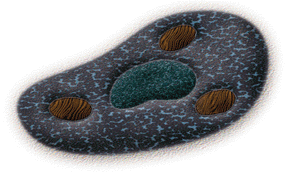

Continued
 The University of Chicago Magazine June 1996
The University of Chicago Magazine June 1996

Continued
coworkers at Scotland's University of Aberdeen described a cleaner culling-a "hitherto little recognized mechanism," today often called programmed cell death. They saw that sometimes cells, rather than exploding, would shrink and then fragment into smaller blobs that were discreetly wrapped up and disposed of by their healthy neighbors, leaving behind no inflammation and little tissue disruption. The Scottish researchers, after consulting a Greek-department colleague, named their discovery apoptosis, which rhymes nicely with necrosis and means a falling off, as petals from a flower or leaves from a tree.
Although apoptosis explained a number of perplexing questions-where did that incipient tail go?-the discovery went largely unheralded until around 1980, when scientists noticed that an apoptosing cell shreds its genetic material to protect its neighbors from infective viruses or its own damaged genes. Still more intriguing, researchers realized that the genetic suicide plan, and the enzymes needed to carry it out, are found in nearly all tissues and in animals from the lowest invertebrates to humans.
"It's a very ancient mechanism," says professor of medicine Craig Thompson, director of the U of C's Gwen Knapp Center for Lupus and Immunology Research and a leading authority on apoptosis. "From the time life started to form multicellular organisms," he believes, apoptosis arose "to make sure each cell obeys the covenant and contributes to the survival of the organism." In fact, death is so central to a cell's life plan that the suicide machinery stands always at the ready: In many cases, a cell's survival depends on constant, reassuring signals from its surroundings that its continued existence is meaningful and valued.
The cell-death machinery comprises several genes. Some of them also prevent rapid growth-the so-called tumor-suppressor genes-and others also encourage it, as potentially cancer-causing oncogenes. The first mammalian gene found to cause apoptosis happened to be an already familiar oncogene-a now-famous stretch of DNA called c-myc. "Everyone always wondered," says Thompson, why cells don't turn cancerous when a mutation forces their c-myc gene into its "on" position. The answer, he says, is that those cells were dying. Although c-myc provides a required chemical signal for the cell to divide, if it's turned on all the time when the cell lacks enough growth factors, the cell-as if frustrated it cannot achieve the growth it now feels it deserves-kills itself. With that 1992 discovery, c-myc became the first gene identified as controlling apoptosis, and so drew dozens of researchers into investigating its two-faced character.
It's a paradox," says Nissim Hay, assistant professor in the Ben May Institute, of the c-myc gene. Hay is studying c-myc and its role in both causing and preventing cancer. "This is an oncogene and should cause proliferation," he says, "but on the other hand, if you deprive the cells of growth factors"-chemical signals passed between cells-"it causes them to die." The paradox, he says, may really be a built-in safeguard against a hyperactive growth signal. "We think it may have evolved as a protection mechanism," he explains, "so that if the cell took one hit," or mutation, "leading to deregulation of c-myc, the cell would rather die than develop a tumor-unless a second event occurs to block the apoptotic pathway."
Hay's laboratory is studying how growth factors and other chemical messengers erect that block by triggering anti-death mechanisms inside the cell. The growth factor-starved cells at a tumor's center, Hays has found, are more sensitive to chemotherapy than its outlying cells. And in fighting cancer, he notes, "most therapeutic agents work by inducing apoptosis." Thus, anti-cancer drugs should deliver a coup de grâce to tumors that overexpress c-myc and have a functioning death pathway. He's demonstrated this sensitivity in the lab with the drug cisplatin, a mainstay of cancer therapy.
For tumors to develop by the c-myc route, then, they need a second "hit": a block in the c-myc death pathway. Tumors do this either by removing or inactivating a critical tumor-suppressor gene called p53--named Science magazine's 1993 molecule of the year--or by overexpressing a gene that bestows cells with immortality. Scientists had located such a gene in 1985. They called it bcl2, because it was found in human B-cell lymphomas. It would soon become the researchers' prime suspect in the apoptosis story.
At first, however, bcl2 was seen as just another oncogene, causing cells to divide, and-when it went on the fritz-to divide excessively. "Bcl2 causes the lymph nodes to just keep growing and growing," Thompson says. It turned out to be an immortality gene that has no effect on division, but blocks programmed cell death. Indeed, bcl2 looked like the final arbiter of cell death. But when molecular geneticists inserted and turned on the gene in a variety of tissues, they confronted a new paradox: It blocked apoptosis in some cases but not in others-suggesting the existence of yet another control mechanism. It was Thompson who headed the team that found the shadowy figure that seemed to be calling the shots in the cell.
Three years ago, his lab, with collaborators at the University of Michigan, found another cell-death regulator-a gene in chickens, closely related to bcl2, that they dubbed bclx. In human cells, they discovered, bclx could create two proteins with conflicting messages: a larger molecule that immortalized cells even better than bcl2, and a smaller molecule that, surprisingly, blocked the action of bcl2 and allowed the cells to die. In fact, the group recently showed that viruses engineered to produce the smaller protein can kill cells from breast, colon, stomach, or nerve cancers. Intriguingly, the bclx viruses killed the cancer cells even as they spared healthy dividing cells, such as blood progenitor cells, suggesting they may help purge cancer from the bone marrow of patients undergoing autologous marrow transplants.
Wherever they looked, Thompson's team found that cells interpret bclx in the right way for the fate of that particular tissue. In the adult brain, where cells are not supposed to divide or die, the long form was detected, presumably conferring immortality. In unstimulated immune cells, the short form was present, allowing these cells to die off as necessary-a potent discovery that linked apoptosis with autoimmune diseases like lupus, in which traitorous immune cells attack the body. "We had always thought that autoimmune disease would turn out to be the result of activation of cells that reacted against the self," Thompson said at the time. "Now we know lots of these cells exist, and the reason you normally don't have a problem is you have ways to kill them off. Their failure to die appropriately is one reason you get a perpetuated immune reaction against yourself."
Closer to the clinical level, Thompson's colleague Jose Quintans has found his interest in lymphocyte regulation also leads to investigating cell death-what he lightheartedly calls "the ultimate regulator of function." An immunologist, professor of pathology, and master of the Biological Sciences Collegiate Division, Quintans focuses on apoptosis in two types of autoimmune disease: myasthenia gravis, with neurology chairman Barry Arnason, and thyroid disorders, with professor of medicine Leslie DeGroot. Despite the success of their labs and others in modeling autoimmune disease in mice, no such disease in humans has yet been linked to apoptosis genes-though many of these studies are just beginning.
Just what are the actual, cellular functions encoded by the immortality genes bcl2 and bclx? Thompson's lab is in a race with others to find out. One way molecular geneticists try to learn what a gene normally does is to remove it-or "knock it out"-altogether. The bcl2 "knockout" mouse didn't provide any simple clue. "It has lots of disease, because it has a hard time maintaining its immune response," says Thompson. "But it's a mouse, and it eats and it drinks and it runs around in its cage and it's fine."
To the disappointment of many, he notes, several other bcl2-like genes were knocked out with even less effect. But the bclx knockout mouse, first created by Dennis Lowe at Washington University, turned out to be another story. "That mouse dies every time, 13 days into embryogenesis," says Thompson. "The minute it tries to form a brain or a liver, they fall apart. Without this gene to tell cells to survive in [developing] organs, you can't get viable organs." The implication is profound: "If you can't regulate programmed cell death, you can't even be an organism. You die before you get there."
Thompson now has a tantalizing clue to what the essential function of bclx might be. Working with researchers at Abbott Laboratories, his lab has determined the structure of the protein encoded by bclx: By comparing it to the database of all known protein structures, they found it most closely resembles an unexpected candidate--
Continue reading "Death by design"
Go to:
Return to June 1996 Table of Contents